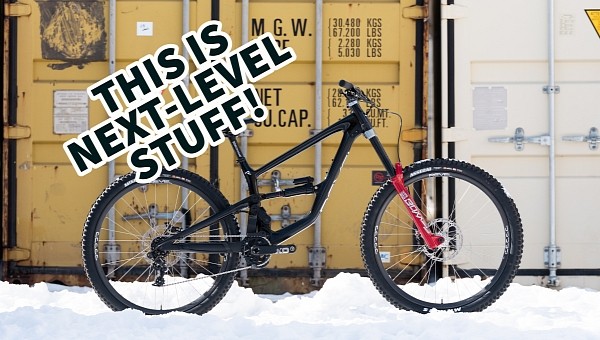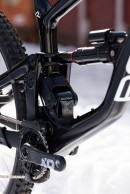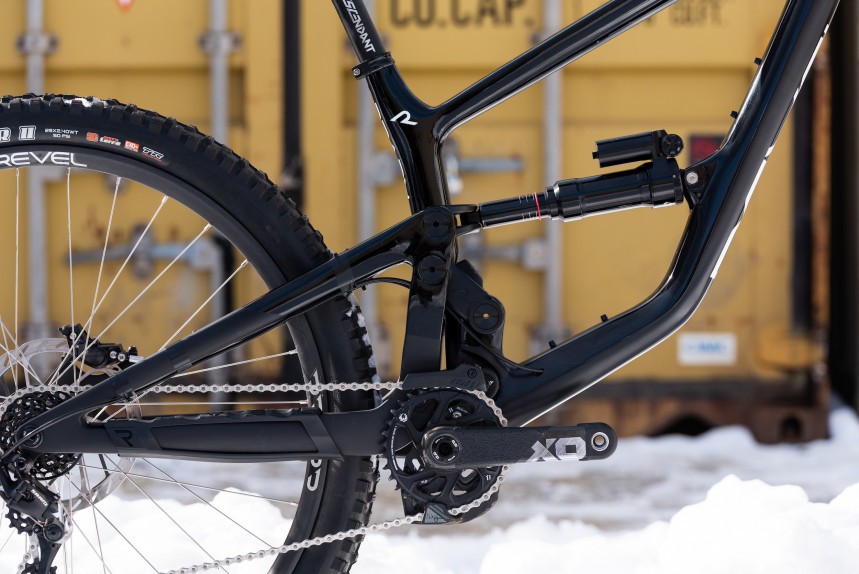Now, I'm a writer, and rider, too, but we'll get there shortly, and as a writer, I like to exaggerate stuff. However, once I finished watching the video about Revel's Rodeo downhill MTB concept, I literally got the shivers. That said, let's take a look at what the heck is going on with this unique two-wheeler and why we need to keep Revel on our cycling radar.
If you ever end up on Revel Bikes' webpage, you'll quickly and easily identify just how this team likes to roll. What is the name of the game? None other than mountain biking or full-suspension frolicking with a side of downhill adrenaline. Sure, they had to build something for folks like me - a hardtail is found in the mix - but the Revel team surely likes to drop off the occasional cliff because its lineup is primarily full squish.
Well, over the past couple of years, Revel has been dreaming, designing, and creating the machine you see here today, the Rodeo. It got its name from the way some members of the Revel crew feel when hitting downhill tracks, like going to a rodeo. But this bucking bull is something else, and the magic you see begins with nothing more than 3D printing.
One of the main differences between the Rodeo and just about any other mountain bike on the market is the way it's built. It's 3D printed with the use of thermoplastic carbon. Again, 3D printed with carbon fiber reinforced polymers! And by the looks of things, it's all achieved through a classic extrusion process. What gave it away are the little scenes in the video below.
Before we go any further, I need to point out a thing or two about how we got here. First of all, 3D printing and additive manufacturing has taken off recently, mainly because we can achieve all sorts of results. We can even build homes using massive printers that expel a concrete mixture, and even some of your car's parts may have been 3D printed.
From there, all it took was a dash of Revel's curious and adventurous style to give birth to the 3D-printed Rodeo. As to why they did it, "We're making cool stuff. We're experimenting with cool stuff. Let's show it off." In short, because they can! This brings me to my final point: we can't own this beast, nor is there any info if the future will change that.
Now, Revel isn't a team that focuses on 3D printing, and so they've called upon the powers of a crew that does, Arevo. Oh, you've heard of this crew before? Of course, you have. They're responsible for another bicycle on the market, the Strata. With their help, Revel was able to bring the Rodeo to life.
More on the magic of the Rodeo, Revel also chose to have a long-time partner in MTB crime, Canfield, develop a suspension system for a long-travel downhill MTB. As we can see in the flick, they gladly accepted. Here, the patented Canfield Balance Formula is in play and focuses the CC right on top of the chain line and chainring. The result is "The most efficient yet active pedaling platform possible, completely independent of sag, travel, and both drivetrain and braking forces." I've yet to test this system, so I can't say how wonderful it is, but everyone's raving about it.
All that amounts to a platform tuned to be set on top of 29 in tires, and best of all, that rear movement allows for 200 mm (7.9 in) of travel. At the front, 190 mm (7.5 in) to 200 mm is what this bronco needs and loves. As for the drivetrain we might find on this machine, it's not clear, but an SRAM UDH (Universal Derailleur Hanger) hints at the possible suspect.
One thing I would have loved to know is just how much the frameset weighs on its own. Why? One of the benefits of 3D printing is being able to control just how much of a material is deposited in any particular spot. This means that Revel shaped the Rodeo with no extra bits than necessary, thus leading to a sleek and lightweight canvas.
By now, you've picked up on the fact that the Rodeo is nothing more than a concept bike. Well, that's at this stage, anyway. According to the website's FAQ, one question is, "When would a 3D bike be feasible to sell?" Revel's response is, "Some time in the future! Maybe sooner than you think!" What does this mean for folks like you and me? It could mean that Revel is aiming for this target.
But being a rather new manufacturing process that needs to hold up to the stresses of downhill domination, the Rodeo will still be sitting around as nothing more than a concept. For the time being, that is. If you're into full-suspension machines and bent on airtime and precision, you should start putting some cash aside for a possible future where you own your own 3D-printed bucking bronco.
Well, over the past couple of years, Revel has been dreaming, designing, and creating the machine you see here today, the Rodeo. It got its name from the way some members of the Revel crew feel when hitting downhill tracks, like going to a rodeo. But this bucking bull is something else, and the magic you see begins with nothing more than 3D printing.
One of the main differences between the Rodeo and just about any other mountain bike on the market is the way it's built. It's 3D printed with the use of thermoplastic carbon. Again, 3D printed with carbon fiber reinforced polymers! And by the looks of things, it's all achieved through a classic extrusion process. What gave it away are the little scenes in the video below.
Before we go any further, I need to point out a thing or two about how we got here. First of all, 3D printing and additive manufacturing has taken off recently, mainly because we can achieve all sorts of results. We can even build homes using massive printers that expel a concrete mixture, and even some of your car's parts may have been 3D printed.
Now, Revel isn't a team that focuses on 3D printing, and so they've called upon the powers of a crew that does, Arevo. Oh, you've heard of this crew before? Of course, you have. They're responsible for another bicycle on the market, the Strata. With their help, Revel was able to bring the Rodeo to life.
More on the magic of the Rodeo, Revel also chose to have a long-time partner in MTB crime, Canfield, develop a suspension system for a long-travel downhill MTB. As we can see in the flick, they gladly accepted. Here, the patented Canfield Balance Formula is in play and focuses the CC right on top of the chain line and chainring. The result is "The most efficient yet active pedaling platform possible, completely independent of sag, travel, and both drivetrain and braking forces." I've yet to test this system, so I can't say how wonderful it is, but everyone's raving about it.
One thing I would have loved to know is just how much the frameset weighs on its own. Why? One of the benefits of 3D printing is being able to control just how much of a material is deposited in any particular spot. This means that Revel shaped the Rodeo with no extra bits than necessary, thus leading to a sleek and lightweight canvas.
By now, you've picked up on the fact that the Rodeo is nothing more than a concept bike. Well, that's at this stage, anyway. According to the website's FAQ, one question is, "When would a 3D bike be feasible to sell?" Revel's response is, "Some time in the future! Maybe sooner than you think!" What does this mean for folks like you and me? It could mean that Revel is aiming for this target.
But being a rather new manufacturing process that needs to hold up to the stresses of downhill domination, the Rodeo will still be sitting around as nothing more than a concept. For the time being, that is. If you're into full-suspension machines and bent on airtime and precision, you should start putting some cash aside for a possible future where you own your own 3D-printed bucking bronco.














